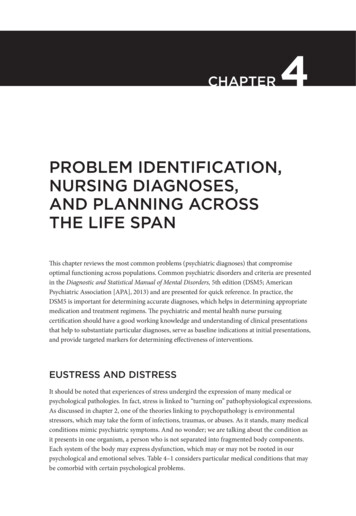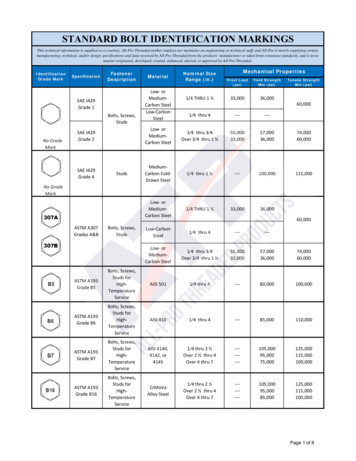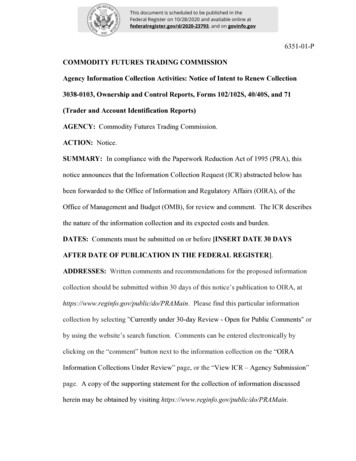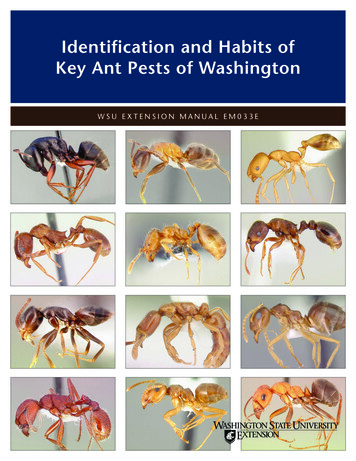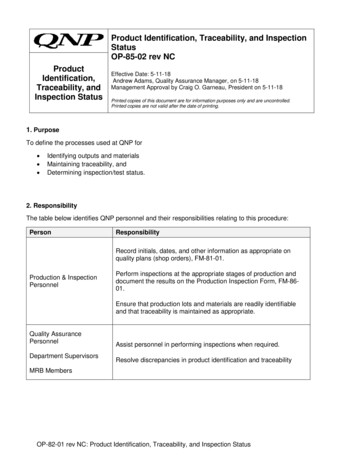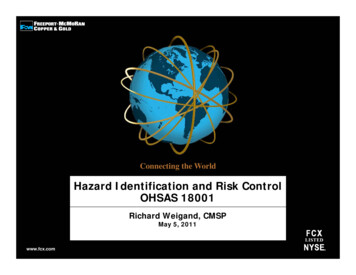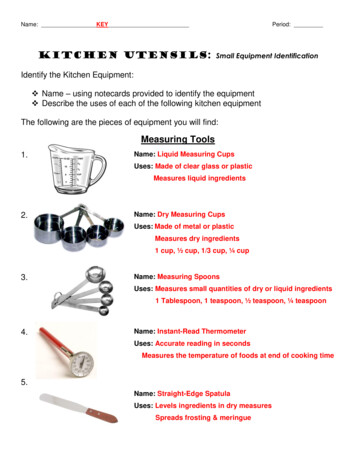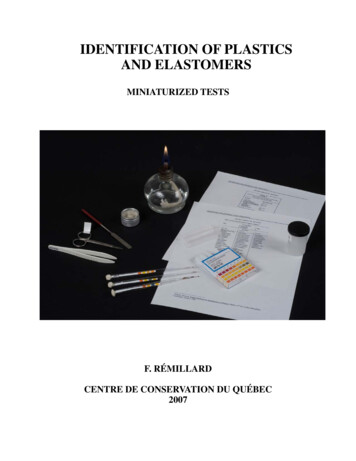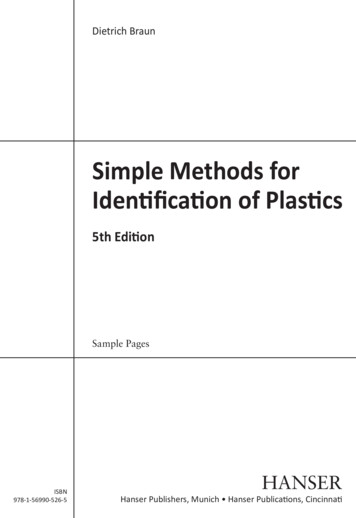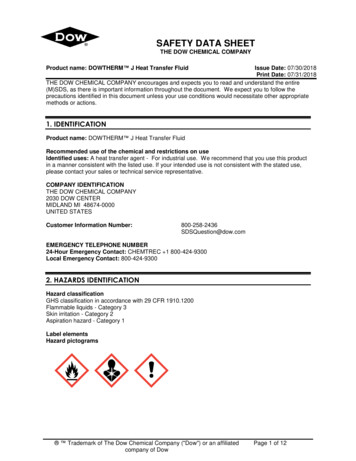
Transcription
SAFETY DATA SHEETTHE DOW CHEMICAL COMPANYProduct name: DOWTHERM J Heat Transfer FluidIssue Date: 07/30/2018Print Date: 07/31/2018THE DOW CHEMICAL COMPANY encourages and expects you to read and understand the entire(M)SDS, as there is important information throughout the document. We expect you to follow theprecautions identified in this document unless your use conditions would necessitate other appropriatemethods or actions.1. IDENTIFICATIONProduct name: DOWTHERM J Heat Transfer FluidRecommended use of the chemical and restrictions on useIdentified uses: A heat transfer agent - For industrial use. We recommend that you use this productin a manner consistent with the listed use. If your intended use is not consistent with the stated use,please contact your sales or technical service representative.COMPANY IDENTIFICATIONTHE DOW CHEMICAL COMPANY2030 DOW CENTERMIDLAND MI 48674-0000UNITED STATESCustomer Information Number:800-258-2436SDSQuestion@dow.comEMERGENCY TELEPHONE NUMBER24-Hour Emergency Contact: CHEMTREC 1 800-424-9300Local Emergency Contact: 800-424-93002. HAZARDS IDENTIFICATIONHazard classificationGHS classification in accordance with 29 CFR 1910.1200Flammable liquids - Category 3Skin irritation - Category 2Aspiration hazard - Category 1Label elementsHazard pictograms Trademark of The Dow Chemical Company ("Dow") or an affiliatedcompany of DowPage 1 of 12
Product name: DOWTHERM J Heat Transfer FluidIssue Date: 07/30/2018Signal word: DANGER!HazardsFlammable liquid and vapour.May be fatal if swallowed and enters airways.Causes skin irritation.Precautionary statementsPreventionKeep away from heat/sparks/open flames/hot surfaces. No smoking.Keep container tightly closed.Ground/bond container and receiving equipment.Use explosion-proof electrical/ ventilating/ lighting equipment.Use only non-sparking tools.Take precautionary measures against static discharge.Wash skin thoroughly after handling.Wear protective gloves/ eye protection/ face protection.ResponseIF SWALLOWED: Immediately call a POISON CENTER/doctor.IF ON SKIN (or hair): Take off immediately all contaminated clothing. Rinse skin withwater/shower.Do NOT induce vomiting.If skin irritation occurs: Get medical advice/ attention.Take off contaminated clothing and wash before reuse.In case of fire: Use dry sand, dry chemical or alcohol-resistant foam to extinguish.In case of fire: Use water spray, alcohol-resistant foam, dry chemical or carbon dioxide toextinguish.StorageStore in a well-ventilated place. Keep cool.Store locked up.DisposalDispose of contents/ container to an approved waste disposal plant.Other hazardsStatic-accumulating flammable liquid.3. COMPOSITION/INFORMATION ON INGREDIENTSSynonyms: diethylbenzeneThis product is a ncentration 95.5 %Page 2 of 12
Product name: DOWTHERM J Heat Transfer FluidIssue Date: 07/30/20184. FIRST AID MEASURESDescription of first aid measuresGeneral advice:First Aid responders should pay attention to self-protection and use the recommended protectiveclothing (chemical resistant gloves, splash protection). If potential for exposure exists refer to Section8 for specific personal protective equipment.Inhalation: Move person to fresh air. If not breathing, give artificial respiration; if by mouth to mouthuse rescuer protection (pocket mask, etc). If breathing is difficult, oxygen should be administered byqualified personnel. Call a physician or transport to a medical facility.Skin contact: Wash off with plenty of water. Suitable emergency safety shower facility should beavailable in work area.Eye contact: Flush eyes thoroughly with water for several minutes. Remove contact lenses after theinitial 1-2 minutes and continue flushing for several additional minutes. If effects occur, consult aphysician, preferably an ophthalmologist.Ingestion: Do not induce vomiting. Call a physician and/or transport to emergency facilityimmediately.Most important symptoms and effects, both acute and delayed:Aside from the information found under Description of first aid measures (above) and Indication ofimmediate medical attention and special treatment needed (below), any additional importantsymptoms and effects are described in Section 11: Toxicology Information.Indication of any immediate medical attention and special treatment neededNotes to physician: Maintain adequate ventilation and oxygenation of the patient. If burn is present,treat as any thermal burn, after decontamination. The decision of whether to induce vomiting or notshould be made by a physician. If lavage is performed, suggest endotracheal and/or esophagealcontrol. Danger from lung aspiration must be weighed against toxicity when considering emptying thestomach. No specific antidote. Treatment of exposure should be directed at the control of symptomsand the clinical condition of the patient.5. FIREFIGHTING MEASURESSuitable extinguishing media: Water fog or fine spray. Dry chemical fire extinguishers. Carbondioxide fire extinguishers. Foam. General purpose synthetic foams (including AFFF type) or proteinfoams are preferred if available. Alcohol resistant foams (ATC type) may function.Unsuitable extinguishing media: No data availableSpecial hazards arising from the substance or mixtureHazardous combustion products: During a fire, smoke may contain the original material in additionto combustion products of varying composition which may be toxic and/or irritating. Combustionproducts may include and are not limited to: Carbon monoxide. Carbon dioxide.Unusual Fire and Explosion Hazards: Violent steam generation or eruption may occur uponapplication of direct water stream to hot liquids. When product is stored in closed containers, aflammable atmosphere can develop. Vapors are heavier than air and may travel a long distance andaccumulate in low lying areas. Ignition and/or flash back may occur.Page 3 of 12
Product name: DOWTHERM J Heat Transfer FluidIssue Date: 07/30/2018Advice for firefightersFire Fighting Procedures: Keep people away. Isolate fire and deny unnecessary entry. Stayupwind. Keep out of low areas where gases (fumes) can accumulate. Use water spray to cool fireexposed containers and fire affected zone until fire is out and danger of reignition has passed. Do notuse direct water stream. May spread fire. Eliminate ignition sources. Burning liquids may be movedby flushing with water to protect personnel and minimize property damage. Avoid accumulation ofwater. Product may be carried across water surface spreading fire or contacting an ignition source.Special protective equipment for firefighters: Wear positive-pressure self-contained breathingapparatus (SCBA) and protective fire fighting clothing (includes fire fighting helmet, coat, trousers,boots, and gloves). If protective equipment is not available or not used, fight fire from a protectedlocation or safe distance.6. ACCIDENTAL RELEASE MEASURESPersonal precautions, protective equipment and emergency procedures: Isolate area. Keepunnecessary and unprotected personnel from entering the area. Refer to section 7, Handling, foradditional precautionary measures. Keep personnel out of low areas. Keep upwind of spill. Ventilatearea of leak or spill. No smoking in area. Vapor explosion hazard. Keep out of sewers. Eliminate allsources of ignition in vicinity of spill or released vapor to avoid fire or explosion. Ground and bond allcontainers and handling equipment. Use appropriate safety equipment. For additional information,refer to Section 8, Exposure Controls and Personal Protection.Environmental precautions: Material may float on water and any runoff may create an explosion orfire hazard if ignited. Prevent from entering into soil, ditches, sewers, waterways and/or groundwater.See Section 12, Ecological Information.Methods and materials for containment and cleaning up: Contain spilled material if possible.Small spills: Absorb with materials such as: Non-combustible material. Use non-sparking tools incleanup operations. Pump into suitable and properly labeled containers. Pump with explosion-proofequipment. If available, use foam to smother or suppress. Collect in suitable and properly labeledcontainers. See Section 13, Disposal Considerations, for additional information.Page 4 of 12
Product name: DOWTHERM J Heat Transfer FluidIssue Date: 07/30/20187. HANDLING AND STORAGEPrecautions for safe handling: Keep away from heat, sparks and flame. Avoid contact with eyes,skin, and clothing. Avoid breathing vapor. Do not swallow. Wash thoroughly after handling. Keepcontainer closed. Use with adequate ventilation. No smoking, open flames or sources of ignition inhandling and storage area. Electrically ground and bond all equipment. Use of non-sparking orexplosion-proof equipment may be necessary, depending upon the type of operation. Vapors areheavier than air and may travel a long distance and accumulate in low lying areas. Ignition and/or flashback may occur. Containers, even those that have been emptied, can contain vapors. Do not cut, drill,grind, weld, or perform similar operations on or near empty containers. Spills of these organicmaterials on hot fibrous insulations may lead to lowering of the autoignition temperatures possiblyresulting in spontaneous combustion. This product is a poor conductor of electricity and can becomeelectrostatically charged, even in bonded or grounded equipment. If sufficient charge is accumulated,ignition of flammable mixtures can occur. See Section 8, EXPOSURE CONTROLS AND PERSONALPROTECTION. Handling operations that can promote accumulation of static charges include but arenot limited to mixing, filtering, pumping at high flow rates, splash filling, creating mists or sprays, tankand container filling, tank cleaning, sampling, gauging, switch loading, vacuum truck operations.Conditions for safe storage: Minimize sources of ignition, such as static build-up, heat, spark orflame.Storage stabilityShelf life: Use within60 Month8. EXPOSURE CONTROLS/PERSONAL PROTECTIONControl parametersIf exposure limits exist, they are listed below. If no exposure limits are displayed, then no values areapplicable.ComponentDiethylbenzeneRegulationUS WEELType of listingValue/NotationTWA5 ppmExposure controlsEngineering controls: Use engineering controls to maintain airborne level below exposure limitrequirements or guidelines. If there are no applicable exposure limit requirements or guidelines, useonly with adequate ventilation. Local exhaust ventilation may be necessary for some operations.Protective measures: Personal protective equipment comprising: suitable protective gloves, safetygoggles and protective clothingIndividual protection measuresEye/face protection: Use safety glasses (with side shields).Skin protectionHand protection: Use gloves chemically resistant to this material. Examples ofpreferred glove barrier materials include: Polyethylene. Ethyl vinyl alcohol laminate("EVAL"). Polyvinyl alcohol ("PVA"). Polyvinyl chloride ("PVC" or "vinyl").Styrene/butadiene rubber. Viton. Examples of acceptable glove barrier materialsinclude: Butyl rubber. Chlorinated polyethylene. Natural rubber ("latex"). Neoprene.Nitrile/butadiene rubber ("nitrile" or "NBR"). NOTICE: The selection of a specific glovefor a particular application and duration of use in a workplace should also take intoaccount all relevant workplace factors such as, but not limited to: Other chemicalsPage 5 of 12
Product name: DOWTHERM J Heat Transfer FluidIssue Date: 07/30/2018which may be handled, physical requirements (cut/puncture protection, dexterity,thermal protection), potential body reactions to glove materials, as well as theinstructions/specifications provided by the glove supplier.Other protection: Use protective clothing chemically resistant to this material.Selection of specific items such as face shield, boots, apron, or full body suit willdepend on the task.Respiratory protection: Respiratory protection should be worn when there is a potential toexceed the exposure limit requirements or guidelines. If there are no applicable exposure limitrequirements or guidelines, use an approved respirator. Selection of air-purifying or positivepressure supplied-air will depend on the specific operation and the potential airborneconcentration of the material. For emergency conditions, use an approved positive-pressureself-contained breathing apparatus.The following should be effective types of air-purifying respirators: Organic vapor cartridge.9. PHYSICAL AND CHEMICAL PROPERTIESAppearancePhysical stateColorOdorOdor ThresholdpHMelting point/rangeFreezing pointBoiling point (760 mmHg)Flash pointEvaporation Rate (Butyl Acetate 1)Flammability (solid, gas)Lower explosion limitUpper explosion limitVapor PressureRelative Vapor Density (air 1)Relative Density (water 1)Water solubilityPartition coefficient: noctanol/waterAuto-ignition temperatureDecomposition temperatureKinematic ViscosityExplosive propertiesOxidizing propertiesMolecular weightLiquid.ColorlessAromaticNo test data availableNot applicable-81 C ( -114 F) Literature-81 C ( -114 F) Literature181 C ( 358 F) Literatureclosed cup 58 C ( 136 F) Setaflash Closed Cup ASTMD3828 0.1 Estimated.Not applicable to liquids0.67 % vol Literature6.03 % vol Literature1 mmHg Literature4.5 Literature0.865 at 20 C (68 F) Literature20 ppm Literaturelog Pow: 4.58 Measured420 C (788 F) LiteratureNo test data available0.98 cSt at 25 C (77 F) LiteratureNo data availableNo data available134 g/mol LiteraturePage 6 of 12
Product name: DOWTHERM J Heat Transfer FluidIssue Date: 07/30/2018NOTE: The physical data presented above are typical values and should not be construed as aspecification.10. STABILITY AND REACTIVITYReactivity: No data availableChemical stability: Stable under recommended storage conditions. See Storage, Section 7.Possibility of hazardous reactions: Polymerization will not occur.Conditions to avoid: Exposure to elevated tem
Product name: DOWTHERM J Heat Transfer Fluid Issue Date: 07/30/2018 Page 5 of 12 7. HANDLING AND STORAGE Precautions for safe handling: Keep away from heat, sparks and flame. Avoid contact with eyes, skin, and clothing. Avoid breathing vapor. Do not swallow. Wash thoroughly after handling. Keep container closed. Use with adequate ventilation. No smoking, open flames or sources of ignition in

